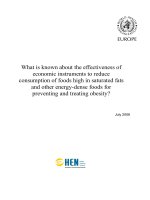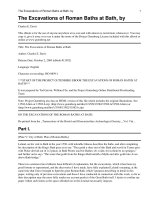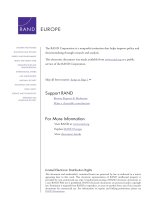the effectiveness of promotion agencies at attracting foreign investment
Bạn đang xem bản rút gọn của tài liệu. Xem và tải ngay bản đầy đủ của tài liệu tại đây (920.84 KB, 125 trang )
TeAM
YYeP
G
Digitally signed by TeAM
YYePG
DN: cn=TeAM YYePG,
c=US, o=TeAM YYePG,
ou=TeAM YYePG,
email=
Reason: I attest to the
accuracy and integrity of
this document
Date: 2005.04.24
06:28:09 +08'00'
The Effectiveness of
Promotion Agencies
at Attracting Foreign
Direct Investment
Jacques Morisset
Kelly Andrews-Johnson
™xHSKIMBy356067zv":;:<:!:'
ISBN 0-8213-5606-2
The Foreign Investment Advisory Service (FIAS), a joint
facility of the International Finance Corporation (IFC) and
the World Bank, was established to help governments of
developing member countries to review and adjust policies,
institutions, and programs that affect foreign direct
investment. The ultimate purpose of FIAS is to assist
member governments in attracting beneficial foreign private
capital, technology, and managerial expertise.
FIAS Occasional Papers report the results of research on
practical issues identified by the staff of FIAS in the course
of their work. The research has either been carried out
or sponsored by FIAS. Further papers will be published as
research findings become available.
The Effectiveness of Promotion Agencies at Attracting Foreign Direct Investment
Morisset and Andrews-Johnson
WORLD
BANK
FOREIGN
INVESTMENT
ADVISORY
SERVICE
OCCASIONAL
PAPER
16
THE WORLD BANK
1818 H Street, N.W.
Washington, D.C. 20433 USA
Telephone: 202-473-1000
Facsimile: 202-477-6391
Internet: www.worldbank.org
E-mail:
FIAS OCCASIONAL PAPERS
1 Wells, Jr., and Wint, Marketing a Country: Promotion as a Tool for
Attracting Foreign Investment
2 Wells, Jr., and Wint, Facilitating Foreign Investment: Government
Institutions to Screen, Monitor, and Service Investment from Abroad
3 Belot and Weigel, Programs in Industrial Countries to Promote
Foreign Direct Investment in Developing Countries
4 Mintz and Tsiopoulos, Corporate Income Taxation and Foreign
Direct Investment in Central and Eastern Europe
5 Sader, Privatizing Public Enterprises and Foreign Direct Investment
in Developing Countries
6 Battat, Frank, and Shen, Suppliers to Multinationals: Linkage
Programs to Enhance Local Companies in Developing Countries
7 Carter, Sader, and Holtedahl, Foreign Direct Investment in Central
and Eastern European Infrastructure
8 Megyery and Sader, Facilitating Foreign Participation in Privatization
9 Donaldson, Sader, and Wagle, Foreign Direct Investment in
Infrastructure: The Challenge of Southern and Eastern Africa
10 Michalet, Strategies of Multinationals and Competition for Foreign
Direct Investment: The Opening of Central and Eastern Europe
11 Spar, Attracting High Technology Investment: Intel’s Costa Rican
Plant
12 Sader, Attracting Foreign Direct Investment into Infrastructure:
Why Is It So Difficult?
13 Wells, Jr., and Wint, Marketing a Country: Promotion as a Tool for
Attracting Foreign Investment (Revised Edition)
14 Emery, Spence, Jr., Wells, Jr., and Buehrer, Administrative Barriers to
Foreign Investment: Reducing Red Tape in Africa
15 Wells, Jr., Allen, Morisset, and Pirnia, Using Tax Incentives to
Compete for Foreign Investment: Are They Worth the Costs?
The Effectiveness
of Promotion
Agencies at
Attracting
Foreign Direct
Investment
FOREIGN
INVESTMENT
ADVISORY
SERVICE
OCCASIONAL
PAPER
16
by
Jacques Morisset and
Kelly Andrews-Johnson
© 2004 The International Bank for Reconstruction and Development / The World Bank
1818 H Street, NW
Washington, DC 20433
Telephone 202-473-1000
Internet www.worldbank.org
All rights reserved.
1 2 3 4 07 06 05 04
The findings, interpretations, and conclusions expressed herein are those of the author(s)
and do not necessarily reflect the views of the Board of Executive Directors of the World
Bank or the governments they represent.
The World Bank does not guarantee the accuracy of the data included in this work. The
boundaries, colors, denominations, and other information shown on any map in this work
do not imply any judgment on the part of the World Bank concerning the legal status of any
territory or the endorsement or acceptance of such boundaries.
Rights and Permissions
The material in this work is copyrighted. Copying and/or transmitting portions or all of this
work without permission may be a violation of applicable law. The World Bank encourages
dissemination of its work and will normally grant permission promptly.
For permission to photocopy or reprint any part of this work, please send a request with
complete information to the Copyright Clearance Center, Inc., 222 Rosewood Drive, Dan-
vers, MA 01923, USA, telephone 978-750-8400, fax 978-750-4470, www.copyright.com.
All other queries on rights and licenses, including subsidiary rights, should be addressed
to the Office of the Publisher, World Bank, 1818 H Street NW, Washington, DC 20433,
USA, fax 202-522-2422, e-mail
ISBN 0-8213-5606-2
Library of Congress Cataloging-in-Publication Data.
Morisset, Jacques.
The effectiveness of promotion agencies at attracting foreign
investment / Jacques Morisset, Kelly Andrews-Johnson
p. cm. — (Occasional paper / Foreign Investment Advisory Service ; 16)
Includes bibliographical references and index.
ISBN 0-8213-5606-2
1. Investments, Foreign. 2. Industrial promotion. I. Andrews-Johnson, Kelly,
1968– . II. Title. III. Occasional paper (Foreign Investment Advisory
Service) ; 16.
HG4538.M5968 2003
332.67'3—dc22
200360059
iii
Contents
Foreword by Louis T. Wells vii
Preface xiii
1 Overview 1
2 Are Investment Promotion Agencies Effective at Attracting
Foreign Direct Investment? 8
Measuring IPA Effectiveness 9
Key Empirical Findings 12
Size Matters for Effective Promotion 14
Technical Appendix 18
3 The Business Environment Matters 24
The Role of the Country’s Environment 24
Empirical Results 25
Lessons for Policymakers 27
Technical Appendix 29
4 The Functions of Investment Promotion Agencies and Their
Effectiveness 32
Overall Ranking by Function 32
iv / Contents
A Closer Look at Each Function 35
Technical Appendix 44
5 Key Internal Characteristics of Investment Promotion Agencies
and Their Roles 45
Main IPA Characteristics 45
Which Characteristics Really Matter? 49
Technical Appendix 52
6 Conclusion and Policy Recommendations 54
Statistical Appendix 56
ANNEX: FIAS-MIGA QUESTIONNAIRE 67
Notes 99
Index 105
Boxes
1.1 Key Findings 4
1.2 Snapshot of a Typical IPA in a Developing Country 5
1.3 Main IPA Functions 7
2.1 Why Investment Promotion Is Useful:
Analytical Arguments 9
2.2 The Debate on IPAs’ Effectiveness in Attracting FDI 10
2.3 The Stability of IPA Budgets over Three- to Five-Year
Periods 11
2.4 IPA Budgets by Region 14
4.1 Investment Promotion Functions 33
4.2 Preinvestment Activities 40
4.3 One-Stop Shops 41
5.1 Snapshot of a Typical IPA in a Developing Country 47
Tables
2.1 IPA Budgets by Income Level of Countries (US$) 15
2.2 Estimated Elasticity Coefficients 23
3.1 The Relationship between IPA Effectiveness
(dFDI/dPE) and External Variables 30
Contents / v
3.2 IPA Effectiveness for Our Sample of Countries 31
4.1 Elasticity of FDI Flows to Variation in IPA Spending
by Function 35
4.2 Average Number of Investors Contacted per Year
by Agency 43
5.1 The Influence of IPA Characteristics on FDI Inflows 53
Appendix Tables
1. Investment Generation Activities (Average per Agency) 65
2. Investor Services (Average per Agency) 65
Figures
2.1 Sources of Funding, Percentage of Total IPA Budget 16
3.1 The Better the Country’s Environment, the Higher the
Impact of Promotion on FDI 26
4.1 IPA’s Main Functions, Average Values in Percent of
Total Budget 34
5.1 Correlation between Number of Mandates and
GDP per Capita 48
Appendix Figures
1. Age of Agency 58
2. Mode of Creation 59
3. Institutional Forms 59
4. Reporting Mechanism 60
5. Export and Investment Promotion (% of Total Agencies
per Income Group) 60
6. Prime Responsibility in Granting Investment Incentives,
Licenses, or Both (% of Total Agencies per
Income Group) 61
7. Investment Promotion and Privatization (% of Total
Agencies per Income Group) 61
8. Annual Budget per Income Group 62
9. Budget Allocation per Agency Function 62
10. Number of Professionals Employed in FDI Promotion 63
11. Staff Qualification 63
12. Average Web Hits and Inquiries per Year 64
13. Advertisement in Domestic and Foreign Media per Year 64
14. Policy Advocacy Activities 66
Foreword
W
ith many millions of dollars being spent annually by govern-
ments on promotion to attract foreign investors to various
countries, a perplexing question has become increasingly impor-
tant: Does investment promotion really work? Jacques Morisset
and Kelly Andrews-Johnson have made a major step in providing
a convincing answer to this and associated questions.
So far, these expenditures, overwhelmingly by governments,
have been largely an act of faith. In writing Marketing a
Country,
1
Alvin Wint and I, both now business school professors,
assumed that this was an act worth the gamble. Our business
school training had convinced us that a company wanting to sell
its output will have to undertake some kind of marketing pro-
gram to bring its product to the attention of consumers, inform
them of its advantages, and create a favorable “brand image.”
Sure, how much to spend and on what kinds of activities are frus-
trating business questions, but marketing is essential. Similarly,
we largely took it for granted that most countries would have to
do some marketing if they wanted to attract investors from
abroad. Some potential investors might know little about the
investment locations, could have no idea of policy changes
recently made, and could use some personal attention in their
viii / Foreword
quest for an investment site. However, others, especially econo-
mists and government officials who control budgets, have been
less sanguine about the benefits of promotion to a country. To be
sure, our Marketing a Country purported to address the question
of whether promotion paid, but almost as an afterthought. The
statistical work in that study involved data from around 1985.
Many countries were just beginning to revise national policies to
reflect the growing view that attracting foreign investment was a
very good thing. Because many countries were not yet trying to
promote investment, we could conduct a very simple test: com-
pare foreign direct investment (FDI) flows into countries that
had promotion activities in the United States with the flows into
countries that didn’t. Of course, we tried to control for other
variables that had been shown to affect FDI, in particular gross
national product (GNP) per capita, inflation, and a country’s cur-
rent account. The study provided some crude support for the
idea that promotion worked and, with some heroic assumptions,
that the cost of promotion per job created was around
US$400–600. The costs of attracting an investor seemed about
equivalent to what perhaps 6 months of income tax holiday—
another way of attracting investment—might cost a country. Put
this way, the tradeoff seemed to favor promotion. But our data
came from more than 15 years ago: The independent variable was
simply whether promotion was undertaken or not, and we had no
indicator of the size or kind of the promotion effort of individual
countries. The methodology was crude, and the results simply
could not address a number of questions that are important for
policy.
Morisset and Johnson offer us much more recent and rich data
from their survey, and they use a more sophisticated methodolo-
gy. As a result, their study is more convincing and addresses many
more questions than earlier work. The authors collected data on
the amount of resources 58 promotion agencies devoted to par-
ticular promotion activities and on those agencies’ organization
and financing. The results are comforting and consistent with
Foreword / ix
ix
earlier findings that promotion does work. The authors could go
further than earlier work, however, and calculate elasticities: on
average, an increase of 10 percent in promotion expenditures
seems to yield a 2.5 percent increase in FDI. Or—in terms that
are perhaps easier to interpret—for the median country, an addi-
tional expenditure of US$60,000 on promotion yields about a
US$5 million increase in FDI. Morisset and Johnson find the
median expenditure on investment by developing countries to be
smaller than one might have expected; even relatively small
expenditures, however, can be worthwhile. However, the study
shows that expenditures below a certain annual level yield few if
any returns.
Equally important, the richer data enabled the authors at least
to suggest answers to questions about which particular kinds of
promotion efforts yield the highest returns to money (and time)
spent. The results are a bit surprising: expenditures on policy
advocacy are at the top of the list of high returns, and efforts at
so-called investment-generating activities produce the smallest
return per dollar spent.
Of course, the results are reported for the “typical” (or medi-
an) investment promotion agency. The authors would strongly
argue that a country should not mechanistically apply their find-
ings without considering the problems and strengths of the par-
ticular country. Where the investment climate is bad, efforts to
improve policy seem sensible; it is helpful to have these results
showing that the expenditures on policy advocacy do work. In
fact, in countries with very poor investment climates, returns to
expenditures on other promotion activities are likely to be espe-
cially low. It may also be the case that image building has a lower
return for large countries that are already well known and regu-
larly tracked by investors than it does for small, little-known
places. Similarly, it is likely that promotion has more impact on
certain kinds of investors than on others, but the study doesn’t
quite answer questions at this level of detail. In the end, even with
the large sample covered in the survey, sample size and other lim-
x / Foreword
its on the availability of data constrain conclusions from statistical
analysis.
The research says some important things about organizational
issues. The results show that agencies with some kind of partici-
pation from the private sector do better than those that are pure-
ly governmental, for example. The opposite is also probably true:
strictly private sector agencies are unlikely to work terribly well.
Purely private agencies are, however, so rare that the study could-
n’t really demonstrate this point. It did provide data that sup-
ported the idea that promotion agencies work better if they are
not part of a ministry, however—it’s better to report to the pres-
ident’s office, for example.
This study goes a long way in addressing questions of impor-
tance to policymakers, much further than anything done before.
Yet, like any research in a really messy area, this study by Morisset
and Johnson doesn’t convincingly tell a reader everything he or
she would like to know. Inevitably, the results can be challenged
based on the possibility that promotion efforts are so correlated
with other policies designed to attract investment that we are
observing not only the impact of promotion, but also the effects
of those other policies. In statistical analysis, there is no com-
pletely satisfactory way to disentangle the effects of policies that
so often come as a package. But the correlations in this study are
so strong that it is hard to believe that promotion is not playing
a significant role. Moreover, anecdotal evidence, such as that
offered by Debora Spar, provides a great deal of confidence that
Morisset and Johnson have it right. The detailed stories give
examples and, more important, illustrate the mechanisms
through which promotion works in influencing foreign invest-
ment decisions.
2
One seemingly important question is not addressed at all in
this study: Does promotion increase the total flow of foreign
investment, and how much, or does it divert investment that
would be made anyway, simply leading it to the country that does
more or better promotion and away from another country? As
Foreword / xi
interesting as the question is, the answer probably doesn’t really
matter. To be sure, if promotion fails to increase the total
amount of investment, then the world would be better off if no
one spent resources on promotion. However, any global agree-
ment—and probably any regional agreement—to limit invest-
ment promotion is highly unlikely. The problems of distributing
the gains from such an accord, if there are gains, are formidable,
and they are not likely to be overcome in the time horizon of any
readers of this research.
In spite of its small and inevitable problems, this research, as
well as the many anecdotal pieces of evidence that are accumu-
lating and arguments by analogy to the needs of businesses to
market their products, all add a great deal of credibility to the
conclusion that investment promotion is worthwhile. For many
businesses, marketing is a more profitable expenditure than
engaging in a price war by cutting prices. For a country, the
equivalent of cutting prices is offering incentives, either tax
breaks or direct subsidies. This study provides more evidence to
suggest that, at least for many countries, a dollar spent on invest-
ment promotion yields a better return than a dollar provided as
a subsidy or a dollar given up through a tax incentive program.
Moreover, this study has many lessons about how to carry out
effective investment promotion. I do not want to reveal all of
those lessons here in the preface—a simplistic summary should
not serve as a substitute for reading this outstanding piece of
research and ferreting out the rich lessons as they apply to indi-
vidual countries.
Louis T. Wells
Herbert F. Johnson Professor of
International Management
Harvard Business School
May 20, 2003
Preface
S
ince 1985, the Foreign Investment Advisory Service has assist-
ed more than 100 countries around the world in their efforts
to attract more and better foreign direct investment. A close rela-
tionship with investment promotion agencies has been devel-
oped as part of this effort. This study aims at providing some
guidance to policymakers and managers of these agencies that are
interested in understanding the conditions—both external and
internal to these agencies—that may make them more effective
in influencing the location decision of multinational firms.
We are especially grateful to Professor Louis Wells from the
Harvard Business School, who was essential at various stages of
this project. Professor Wells has not only contributed to our
knowledge of the role of promotion agencies around the world,
but he has also provided us with continuous encouragement. We
also benefited from the comments of Joseph Battat, Frank Sader,
Neil Roger, Joel Bergsman, Dale Weigel, David Bridgman,
Simeon Djankov, Teresa Andaya, and participants at the Annual
Conference of the World Association of Investment Promotion
Agencies (WAIPA) in Geneva on January 22–23, 2003.
Anne Miroux and Alejandro Alvarez contributed to the real-
ization of the survey of about 100 investment promotion agen-
xiv / Preface
cies conducted by the Foreign Investment Advisory Service
(FIAS) between February and May 2002. We thank all the indi-
vidual agencies that responded to our numerous questions, as
well as the Investment Marketing Services unit of the
Multilateral Investment Guarantee Agency (MIGA) and WAIPA,
that have supported this project since its beginning. Finally,
Nicole Smith provided technical assistance for the database and
the statistical analysis.
1
1
1
1
1
Overview
M
r. Smith, general manager of a U.S. firm, became interested
in investing in West Africa. His interest arose from a series of
advertisements in the Financial Times and from several websites
praising the advantages of these countries, such as: “Ivory Coast:
The Best of New Markets,” “Senegal: The Perfect Choice,” or
“Niger: A Country Open to Your Investment.”
1
Partially con-
vinced, Mr. Smith traveled to Africa and was welcomed by the
local investment promotion agency, which responded to his mul-
tiple enquiries. In the end, Mr. Smith opened a subsidiary in one
of these countries. He did not forget to thank the investment
promotion agency, which played a pivotal role.
A similar story could be told about Mr. Smith in Singapore,
Dublin, Dar es Salaam, or Riga. Establishing an investment pro-
motion agency (IPA) has become a central part of most coun-
tries’ development strategies. Today, there are more than 160
national IPAs and more than 250 subnational ones worldwide.
2
This trend is relatively new—only a handful of these agencies
existed 20 years ago.
Currently, little is known about these agencies’ activities, espe-
cially in developing countries. For example, what volume of
resources do countries spend on investment promotion? What are
2 / The Effectiveness of Promotion Agencies
the main activities of the IPAs? To what extent is the private sec-
tor involved in the promotion effort? What are the institutional
links between IPAs and governments? The standard cited most
frequently for best practice in IPAs is based largely on the expe-
riences of a few countries, mostly from industrial countries.
Ireland’s Industrial Development Agency (IDA) and Singapore’s
Economic Development Board (EDB), in particular, top the list
as models.
3
However, there is much to be learned about current
practices in developing countries and whether their IPAs have
been able to fulfill the expectations of policymakers.
Due in part to a lack of reliable data, no broad empirical study
of investment promotion agencies and their effectiveness in
attracting foreign direct investment (FDI) has been done to
date.
4
This empirical gap means that the debate on the effective-
ness of IPAs is still very open. Critics of promotion have ques-
tioned whether the successes of a few IPAs can be replicated else-
where and whether resources made available to these agencies are
a good use of public resources. In the critics’ view, there is a dan-
ger that investment promotion has become the latest fad among
countries, especially developing ones, that are pinning unrealistic
expectations on this tool’s performance.
The main question that we have tried to address is: To what
extent does investment promotion help explain cross-country
variations in FDI flows? We use data from a new survey of 75
IPAs that was conducted between February and May 2002.
5
At
the outset, it should be emphasized that our research should be
viewed as a first step toward filling the existing empirical gap, and
it has some obvious limitations. The most important is that we
have been able to examine empirically the relationship between
promotion and FDI only for the year 2001. Unfortunately, data
are simply not available for additional years. We believe that the
study nonetheless provides some answers to four sets of ques-
tions that should help IPA managers and policymakers develop a
better understanding of the conditions—both external and inter-
nal to the agency—that influence the effectiveness of promotion:
Overview / 3
■ How does the amount of spending on investment pro-
motion affect its effectiveness? Does an agency need to
exceed a minimum level to have any effect on interna-
tional investors?
■ To what extent does the business environment or the
country’s characteristics affect the effectiveness of invest-
ment promotion? Does the quality of the general busi-
ness environment matter?
■ Does the effectiveness of investment promotion vary
according to the functions or activities on which it focus-
es? Should an IPA devote more resources toward policy
advocacy or image building?
■ Is the effectiveness of investment promotion influenced by
different agencies’ characteristics, such as their structure,
mandate, sources of funding, and institutional relationships?
This study looks at the effectiveness of IPAs in terms of the
association between their promotional spending and FDI. It aims
at capturing trends and stops short of the detailed cost-benefit
analysis needed to fully evaluate IPA effectiveness. The results of
our investigation show that investment promotion partially
explains cross-country variations in FDI flows, suggesting that
IPAs were effective in influencing Mr. Smith’s decision to invest
in the example given at the beginning of this chapter (box 1.1).
Of course, as for similar results derived from cross-country
regressions, this finding should be interpreted with caution.
There are many problems in doing such an evaluation, especially
the limited number of observations used in our analysis and the
possibility that both promotion and FDI could be responding
simultaneously to other factors.
Still, our results show that, on average, spending by IPAs was
positively associated with attracting FDI, along with the influ-
ence of key factors such as the quality of the investment climate
and the country’s market size. They were also effective despite
being small and having a narrow scope of responsibilities.
4 / The Effectiveness of Promotion Agencies
Although most IPAs have very small budgets, we observed
that size, nonetheless, does seem to matter (box 1.2). There are
minimum levels of IPA expenditures, which explain cross-coun-
try FDI flows. Perhaps the agency must be of a certain size to be
on the “radar screen” of potential investors.
The finding that promotion is associated positively with FDI
has to be qualified. Mr. Smith in our example would not have
been convinced by the IPA if the country’s investment climate
had been unattractive. A similar relationship exists with respect
to a country’s level of development, as measured by the income
per capita. These results suggest that promotion should be con-
Box 1.1 Key Findings
■ Greater promotion is associated with more FDI, along with the
influence of the market size and quality of the investment climate.
■ The IPA budget needs to be beyond a minimum level to exploit
the increasing returns associated with most promotion activities.
■ IPA effectiveness strongly depends on the country’s business envi-
ronment. It is positively correlated with the quality of the invest-
ment climate and the level of development.
■ Countries with relatively few assets, as reflected by poor invest-
ment climates or low levels of development, get better results
from improving these conditions than from spending limited
resources on investment promotion.
■ Policy advocacy appears to be the most effective function, fol-
lowed by image building and investor service. Investment genera-
tion is not associated with higher FDI flows, even though it
absorbs the greatest share of most IPA budgets.
■ Strong reporting mechanisms to the highest political level, as well
as participation by the private sector, contribute to increasing the
IPA’s visibility and credibility and thus reinforce effectiveness in
attracting FDI.
Overview / 5
sidered as a complement to—rather a substitute for—policies
that create an attractive investment climate. Indeed, we believe
promotion alone can even be counterproductive in a country
that offers a poor investment climate. It seems more difficult to
convince investors to come back if they were disappointed or dis-
illusioned during their first visit to a country. Disappointed
investors are also likely to be vocal about their disenchantment,
which discourages other potential investors. Thus, policymakers
should focus their efforts on improving the country’s fundamen-
tals rather than spending resources, both financial and human,
on investment promotion when these fundamentals are not in
place or far from international standards.
Not surprisingly, the scope of activities that an IPA undertakes
influences performance. Following Wells and Wint (2001), we
distinguish four key functions: policy advocacy, image building,
investor services, and investment generation (box 1.3). Our
Box 1.2 Snapshot of a Typical IPA in a Developing Country
A typical IPA in a developing country is relatively new, created less
than 10 years ago, by either a decree or a law, and it is constituted as
a public body, as part of a ministry, or as an autonomous agency. It
usually reports to a minister, a board of directors, or both.
Most often, its mandate goes beyond FDI promotion and includes
domestic investment and export promotion. Still, IPAs rarely under-
take the primary responsibility for privatization of key sectors of the
economy—such as mining, agriculture, and special economic or
industrial zones—thus limiting capacity to attract FDI in these areas.
The median developing country agency has a budget of under
US$450,000 and employs 10 professional staff. IPAs in developing
countries typically concentrate most financial resources on image
building (38 percent of spending), followed by investment genera-
tion (29 percent), investor services (25 percent), and policy advocacy
(8 percent).
6 / The Effectiveness of Promotion Agencies
empirical results suggest that policy advocacy is most associated
with attracting investment, followed by image building and
investor services. Investment generation appears to be the least
cost effective, partly because it is expensive and partly because it
is often not adapted to the reality of our sample of countries that
have relatively poor investment climates and low levels of eco-
nomic development. Of course, the optimal budget allocation to
each function depends on the specific country, but our results
suggest that most agencies would gain by devoting more atten-
tion to policy advocacy. This function remains the least favored
by most agencies, accounting for only 7 percent of their budgets
on average, compared to more than 33 percent for investment
generation activities. The returns to increased effort on improv-
ing policy appear to be high enough to justify more effort.
Certain characteristics of IPAs are associated with greater
effectiveness in attracting FDI. Political visibility and participa-
tion of the private sector appear to be two elements that are asso-
ciated with success of IPAs in attracting FDI. Political visibility is
best attained when the agency is linked directly to the highest
government officials (for example, the president or the prime
minister), but fewer than 10 percent of the surveyed agencies
have been able to establish such links. Private sector involvement
can be secured through participation in the board that supervis-
es the agency. A board with private representatives is used by
about half of the surveyed agencies. Mr. Smith, our private
investor, was convinced more easily to invest by an agency that
benefits from the support of the private sector, because this tends
to increase the credibility of promotion efforts.
Overview / 7
Box 1.3 Main IPA Functions
Image building creates the perception of a country as an attractive
site for international investment. Activities commonly associated
with image building include focused advertising, public relations
events, the generation of favorable news stories by cultivating jour-
nalists, and so on.
Investor facilitation and investor services refer to the range of ser-
vices provided in a host country that can assist an investor in analyz-
ing investment decisions, establishing a business, and maintaining it
in good standing. Activities in this area include information provi-
sion, “one-stop shop” service aimed at expediting approval process,
and assistance in obtaining sites, utilities, and so on.
Investment generation entails targeting specific sectors and com-
panies with a view to creating investment leads. Activities include
identification of potential sectors and investors, direct mailing, tele-
phone campaigns, investor forums and seminars, and individual pre-
sentations to targeted investors. Investment generation activities can
be done both at home and overseas.
Policy advocacy consists of the activities through which the
agency supports initiatives to improve the quality of the investment
climate and identifies the views of the private sector on that matter.
Activities include surveys of the private sector, participation in task
forces, policy and legal proposals, and lobbying.
8
2
2
Are Investment Promotion
Agencies Effective at Attracting
Foreign Direct Investment?
N
early every country has established an IPA as part of its strat-
egy to attract FDI. When governments use these agencies to
promote economic development, they need to evaluate if they
get “the bang for their buck,” yet very little research on this sub-
ject exists. Surprisingly, it also stands out from our survey that
most IPAs do not report any attempt to evaluate the contribu-
tion in the country’s effort to attract more FDI.
6
In this chapter, we evaluate whether investment promotion
affects inflows of FDI across a relatively large set of countries.
Although this chapter presents the broad findings, it does not
deal with the important issues of the conditions that make pro-
motion especially effective (or ineffective) or what promotion
activities seem to matter the most for FDI. The overall findings
indicated, however, that promotion seems to make a difference.
An initial word of caution is necessary. Our research does not
aim to justify the theoretical underpinnings of adopting invest-
ment promotion policies to attract FDI. Wells and Wint (2001)









